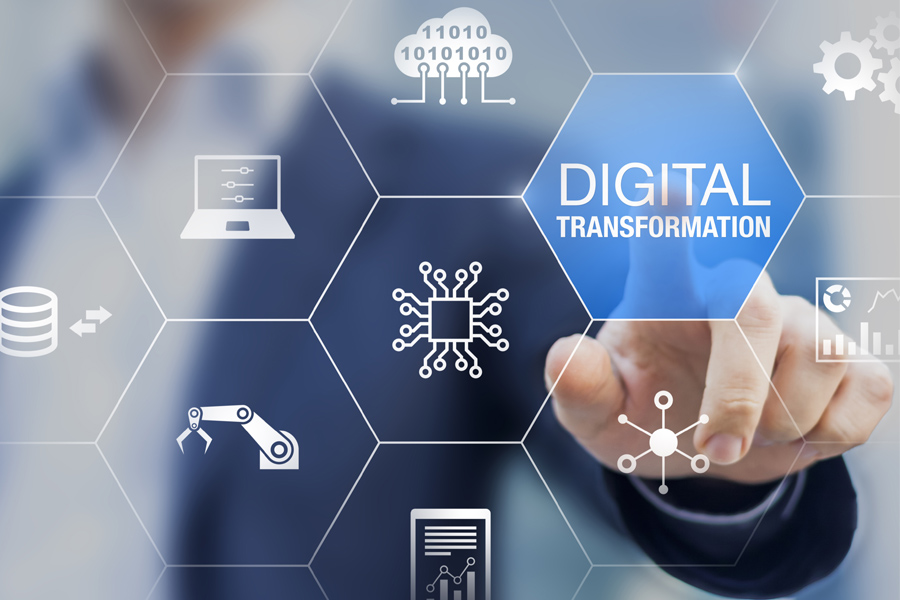
In this issue, we will discuss what we should do to build a data-driven company, the goal of digital transformation we discussed in the previous issue. Let's find out what we should drive as data, how to remove inhibitors along the way to achieve operation based on data, and how to create enablers.
In addition, we will discuss how to manage digital transformation initiatives. But first, consider this: Many companies have introduced various innovations. Is it then okay to manage the digital transformation at a similar level for the previous innovation tasks? Let’s find the answers.
1. What should we digitalize? (Digital operations)
How can we find digitalization tasks? The first thing that comes to my mind might be referring to the best practices. In other words, it is getting inspired by the success stories of companies in the same or similar industries that achieved great performance through digital transformation. This is a good method, for sure. Numerous previous innovations have found an idea from those best practices. However, the concept is a relatively new paradigm where there is fewer best practices. In addition, mid- to long-term performances may not yet be verified (therefore, the consulting industry usually uses “use case” more than ”best practice” for digital transformation).
Another way is to look for opportunities for digital transformation in the business. To do so, it is necessary to explain the word digitalization with more realistic words. In the last issue, we discussed the common characteristics of digital companies. If we look for realistic keywords, then “prediction,” “automation,” and “personalization” may be hints about the digital transformation.
The word automation means finding out the part of your work that needs to be automated. Automation work can be simple and repetitive tasks or work that requires the same constant output. However, this method demands knowledge and experience in digitalization. It would be good to find opportunities in each value chain and process with keywords on digital transformation and review the use cases to get ideas for digitalization opportunities. You cannot create a perfect list on the first try. You should review and make an agreement on a series of ideas, prioritize focusing on small but realistic ideas, and plan them as future work.
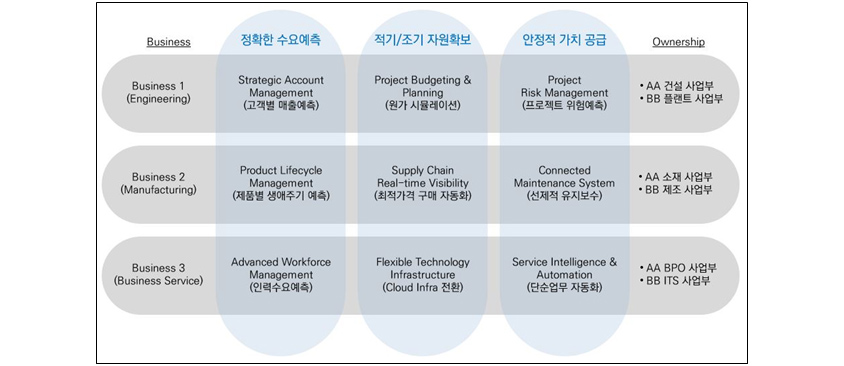
- Business1 (Engineering)/Strategic account management (Predict revenue from individual customers)/Project budgeting & planning (Cost simulation)/Project risk management/AA construction division, BB plant division
- Business 2 (Manufacturing)/Project life cycle management (Predict product life cycles)/Supply chain real-time visibility (Automated purchasing at the best price)/Connected maintenance system (Proactive maintenance)/AA materials division, BB manufacturing division
- Business 3 (Business service)/Advanced workforce management (Predict manpower demand)/Flexible technology infrastructure (Cloud infra transformation)/Service intelligence & automation (Automation of simple and repetitive works)/AA BPO division, BB ITS division
[Figure 1] shows an example of a series of initiatives. There are three themes among the common value chain of various businesses in a company: Accurate prediction of demand, securing resources early and at the right time, and stably providing the value. We defined the things to create data-based insights in businesses and the themes. That is, what should be predicted, automated, personalized, and what should have flexibility.
The thing is, we are promoting digital transformation today. Therefore, we are looking for opportunities to “generate insights from data, make decisions and practice based on them” rather than process efficiency, cost reduction, or enhanced competitiveness. Therefore, we need to create opportunities for change within the basic theme of a data-driven company.
2. What capability should we retain? (Digital capabilities)
Promoting digital transformation needs secure infrastructure and digital technologies to collect and analyze shared data. In addition, a digital workspace to support immersive and collaborative work is required. However, like we addressed in the last issue, well-chosen digital operations work, and the required infrastructure and technologies may not be enough to get insights or decisions and perform through the insights.
Lack of data, poor technical performance, and lack of knowledge and know-how may be the culprit. However, the invisible may be more important here. The lack of leadership (belief) for digital transformation, the mindset of employees to avoid challenges, and the exclusive work culture to do the work internally question ourselves, “Can it be really possible?” and makes us lag behind. In addition, a business management method that does not allow for failure and requires instantly visible performance may get us off the track from the original direction.
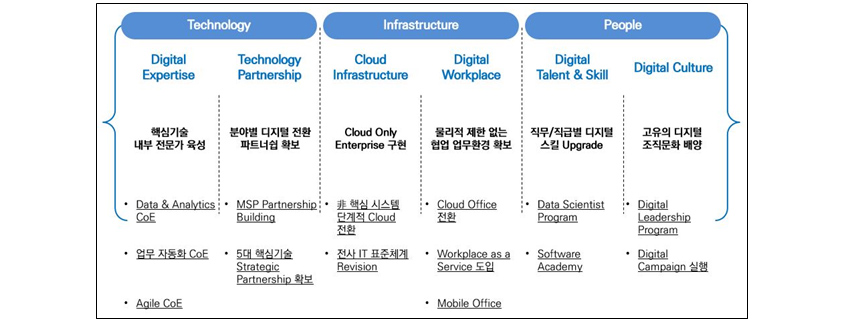
- Digital expertise: Core technology, nurturing internal expert - Data & analytics CoE, office automation CoE, agile CoE
- Technology partnership: Digital transformation by sectors, ensuring partnership - MSP partnership building, five major core technologies, ensuring strategic partnership
- Cloud infrastructure: Realize cloud only enterprise - Phased cloud transformation of non-core systems, revision enterprise IT standard system
- Digital workplace: Ensure cooperation and work environment without physical limitations - Transformation to cloud office, introduce workplace as a service
- Digital talent & skill: Upgrade skills for job responsibility/positions - Data scientist program, software academy
- Digital culture: Nurture unique digital work culture - Practice digital leadership program, digital campaign
In addition to securing digital technology and infrastructure, we need to focus on “people.” We need the right awareness of leadership on digital transformation, individual talent, and skill nurturing in the working level personnel, and most important, digital work culture activities. In a nutshell, a digital work culture is customer-driven, performance-driven culture, experimental spirit (rather than avoiding risks), collaboration (not by myself or ourselves), and communication-based on data (rather than gut feelings).
*Source: MIT Sloan Management Review, 2019
One of the common problems for promoting digital transformation is “there are no people (experienced or expert) to do so.” How many of you or business experts actually have experienced such? We need to learn, experience, and develop our expertise. Therefore, many companies plan internal training programs. But we can’t get expertise for a particular technology and the capability to create business insights from data overnight. There may need to be more than one or two years.
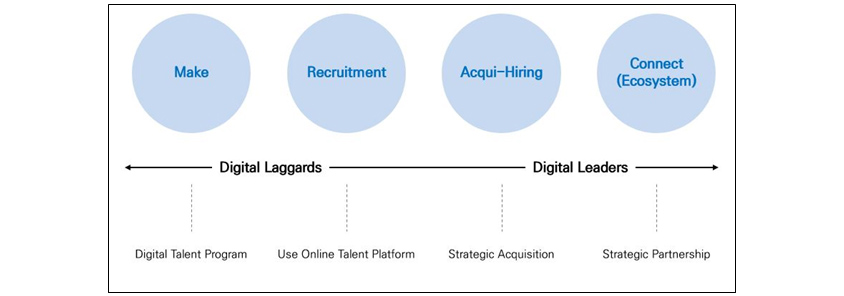
- digital laggards
- digital talent program/use online talent platform
- digital leaders
- strategic acquisition/strategic partnership
McKinsey's report on securing digital talent says advanced companies (digital leaders) aggressively use recruitment over internal training, strategic acquisition over recruitment, and partnerships over strategic acquisition to acquire necessary professionals. Korean companies are very conservative in acquisitions, partnerships, and even recruitment. If the working-level team finds suitable personnel, in many cases, strict hiring standards and processes prevent actual hiring.
Companies dreaming of digital transformation should consider typical work culture topics, including conservative “we” culture personnel systems, investment criteria focusing on risks, and awareness of the value chain to consider partners as a provider and partnerships as a purchase.
3. Promotional framework on the business level
Once the digital transformation initiatives have been outlined, a “system” to drive the initiatives should be started. Korean companies already have decades of innovation experience and systemic internal innovation processes. Therefore, they can reach successful digital transformation. However, if they look over the differences in characteristics between existing innovations, such as process innovation (or PI) and digital transformation, and initiate the right initiatives, then they can achieve good chances for digital transformation.
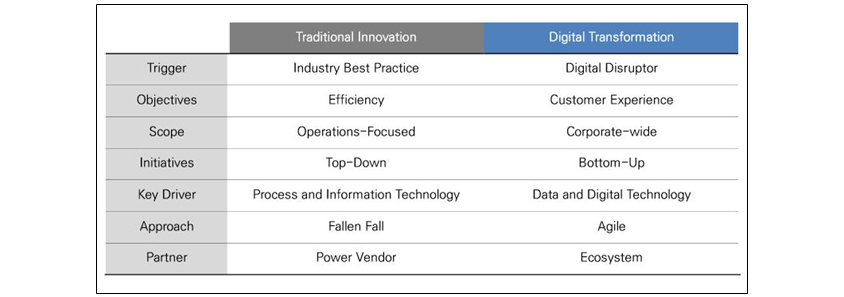
- trigger-industry best practice/digital disruptor
- objectives-efficientcy/customer experience
- scope-operations-focused/corpoorate-wide
- initiatives-top-down/bottom-up
- key driver-process and information technology/data and digital technoligy
- approach-fallen fall/agile
- partner-power vendor/Ecosystem
While the existing innovations were focused on efficiency, digital transformation has a slightly different direction of “creating a new customer experience.” The big goal of digital transformation of enterprises needs a customer point of view for a new customer experience rather than previously improved internal efficiency and competitiveness.
The way to introduce it is also different. The existing innovations often included a type of system construction, such as processes and information systems, and took months and years of phased introduction processes. However, various attempts at digital transformation tend to be Agile as their goals are not to build a whole system from A to Z. So, it mimics the way digital natives caused disruptions in the industry.
We can draw the big picture (framework) of what mechanism our digital transformation will run based on these characteristics of digital transformations. We can set visions and big goals to be achieved through digital transformation, which, in turn, can be broken down into their details and sub-KPIs.
Operations and capability goals achieved through long consideration and consultation can be listed according to the relationship and priority, and the shared or fundamental topics can be handled by a separate TF team.
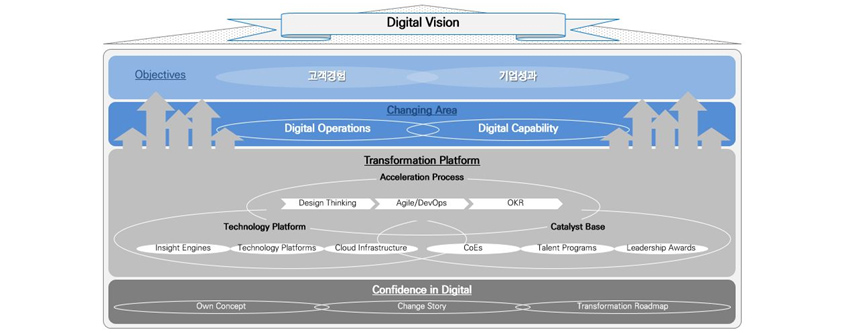
- Objectives, Customer experience, Performance
- Changing area - Digital Operations, Digital Capability
- Transformation Platform - Acceleration Process (Design Thinking, Agile/DevOps, OKR), Technology Platform (Insight Engines, Technology Platform, Cloud Infrastructure), Catalyst Base (CoEs, Talent Programs, Leadership Awards)
- Confidence in Digital - Own Concept, Change Story, Transformation Roadmap
[Figure 5] shows the digital transformation framework in five layers. On the top, there are visions and goals and related initiatives layers. There is a transformation platform and confidence in digital layers at the bottom.
The transformation platform is the foundation of the smooth realization of various digital transformation attempts. A technical platform and expert pools to support the tasks (e.g., expert organization), an agile methodology helping rapid and effective progress for tasks, etc., should be established for the digital transformation platform. In particular, there is a saying, “start small, then scale-up!” in digital transformation. Even to realize the saying, transformation platform is an important element in the digital transformation framework.
Confidence in digital explains a kind of change-based management system. Companies need to incorporate their digital transformation, deliver success stories internally, and manage the long-term journey to achieve digital visions. Perhaps it is more important than individual tasks.
Success stories on digital transformation often say their goal is employee experience. What is the employee experience, and why it even becomes a goal of digital transformation?
Wikipedia defines employee experience as “a set of psychocognitive sentiments about the experiential benefits of employment. The employee experience is formed when an employee interacts with the management, supervisors, coworkers, customers, etc., affected by the working condition and work environment, and leads to particular behaviors related to the employee's job.” In addition, related studies (Kaveh Abhari, Norizan Mat Saad, etc.) show that a positive employee experience, directly or indirectly, creates a positive customer experience through their work. In other words, the employee experience is an important parameter with a great impact on the customer experience, which is a goal of digital transformation.

- Org Vision -> Recognition for Work -> Employee Experience < - Org. Culture
- Workplace -> Employee Experience -> Process < - Talent & Skill
- Input Data -> Process < - Employee Support
- CRM -> (Work Output ->) Customer Experience -> Feedback
- Performance < - Customer Experience (->Customer Value) -> Market Reputation
- Input Data -> Process < - Employee Support
4. Transformation journey
Digital transformation is often referred to as a journey. It means that you can go a long way with trials and errors, and on a bigger scale, your company becomes not only a small success story of digital tasks but a completely different company.
Many organizations use maturity to describe each step in a digital transformation journey. That said, digital technology will gradually develop from applying new digital technologies ad-hoc, making a system for the entire enterprise, and finding the performances in customer experience change to a level that ensures new competitiveness.

- Ad-hoc Digital and/or Agile Adoption
- These digital trials do not aim for innovation in customer experience
- Empathy for agile digital strategy in customer experience and business strategy
- Digital projects as a strategic task and experimental attempts for a pilot test
- Form empathy based on feasibility
- Start trying with innovation in customer experience and attempt a new digital transformation for a company
- Seeking the enterprise methodology for internal innovation, managing digital transformation roadmap
- Gradual improvements under customer-driven digital product/services strategy
- Hybrid of two environments of existing IT and digital resources (Two-speed IT)
- Disruptive digital transformation in internal processes and expand to business model transformation
- Run a fully incorporated, digital-based IT service model
We can borrow the concept of maturity to draw the entire digital transformation journey in a “transformation journey map” (not a road map for a single task or theme). If you set transformation images for the entire enterprise and each step, you can specify the digital vision and excavate, once invisible, mid- to long-term requirements.
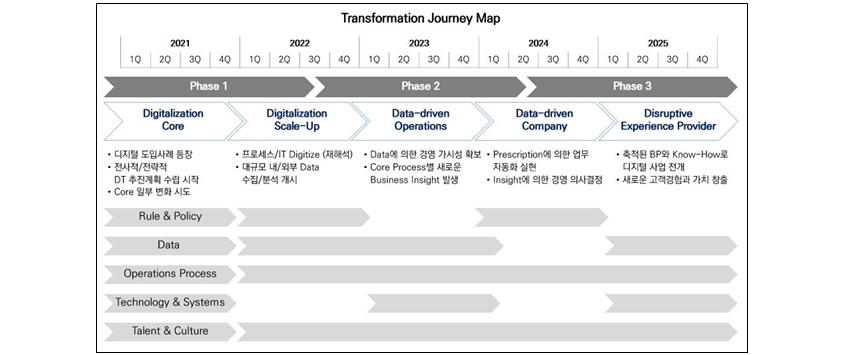
- 2021 to Q2 2022
- Phase 1: Digitalization core - The emergence of digitalization, The establishment of enterprise/strategic DT initiatives, The beginning of the transformation in part of the core processes
- Q3 2022 to Q2 2024
- Phase 2: Ensuring management visibility through digitalization scale-up and data-driven operation-data, Generate new business insights for each core process
- Q3 2024 to Q4 2025
- Phase 3: Data-driven Company, Disruptive experience Provider - Promote digital business with accumulated BP and know-how, Create new customer experience and values
- rule & policy : digitalization core, digitalization scale-up,data-driven company
- data-digitalization scale :up,data-driven operation,disruptive experience provider
- operation proces s: digitalization scale-up, data-driven operation, data-driven company, disruptive experience provider
- technology & system : data-driven operation, disruptive experience provider
- talent & culture : digitalization scale-up, data-driven operation, data-driven company, disruptive experience provider
While we are talking about digital maturity, you might be wondering about what our company would score. In fact, this question comes from many companies. The reason behind the question is to know the current status and target to-be level for digital transformation for your company.
We can break down this question into two parts. One is the corporate-wide question, “What level is our company in general?” and the subject-specific question, “What level is our company in terms of specific works or capabilities?”
Digital maturity indexes to stimulate the needs of such companies have been developed and used in the past years. Strategy consulting firms, such as McKinsey and BCG, operation consulting firms, such as Deloitte and PwC, and SI companies suggest various models to check the corporate-wide digitalization levels.
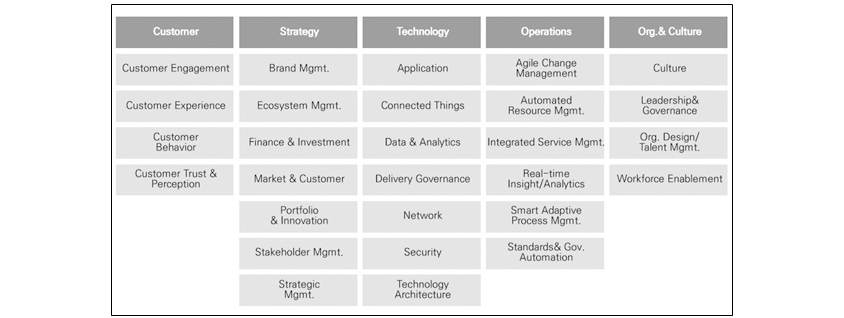
- customer engagement,customer experience,customer behavior,customer trust & perception
- brand Mgmt., Ecosystem Mgmt.,finance & investment, market & customer,portfolio & innovation,stakeholder Mgmt., strategic Mgmt.
- application, connected things, data & analytics,delivery governance, network, security, technology architecture
- agile change management, automated resource Mgmt., integrated service Mgmt., real-time insight/analytics, smart adaptive process Mgmt., standard & gov. automation
- culture, leadership & governance, org. design/talent Mgmt., workforce enablement
S-Core and Samsung SDS have been providing diagnostic services for these two digital levels since 2020: The Enterprise Digital Transformation Assessment (DTA) from the corporate-wide perspective and Specialized Diagnosis (Biz∙Tech∙Culture DTA) from the subject-specific perspective. You can easily check online via the link below.
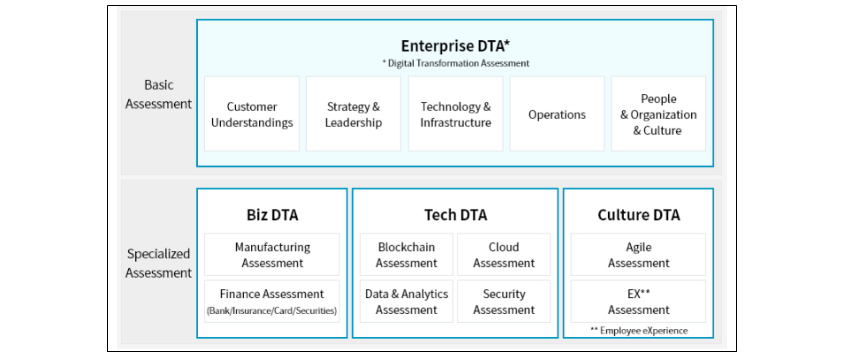
- enterprise DTA
- customer understandings, strategy & leadership, technology & infrastructure, operations, people organization & culture
- Biz DTA - Manufacturing diagnosis, Finance diagnosis (bank/insurance/card/securities)
- Tech DTA - Blockchain diagnosis, Cloud diagnosis, Data & Analytics diagnosis, Security diagnosis
- Culture DTA - Agile diagnosis, EX diagnosis (Employee eXperience)
(Source: Samsung SDS website (Sample Test : https://digital-transformation-assessment.sally.coach/survey/BOGJYZQRKAAA))
Therefore, we recommend just obtaining qualitative insights for diagnoses at this level. Consider them as forming empathy for our weaknesses. It may not be a good approach to blindly seek gap filling strategies with great emphasis on gap figures between advanced levels (peer data).
5. Epilogue
We’ve explained digital transformation, such as data-driven companies, one way of approach, categorization of digital operations and digital capability, the importance of invisible capabilities, promotion framework emphasizing the transformation platform and change management system, and the need for mid- to long-term management of digital transformation with a journey concept in two articles.
We hope this article is useful for doing digital tasks or promoting your company's digital transformation.
▶ The content is protected by the copyright law and the copyright belongs to the author.
▶ The content is prohibited to copy or quote without the author's permission.

Strategic Process Innovation Team, Consulting Business Unit, S-Core Co., Ltd.
A senior consultant of the S-Core Consulting Division for implementing high-tech, IT services, the technology convergence industry, digital business, digital technology based new business, and digital transformation strategies.
